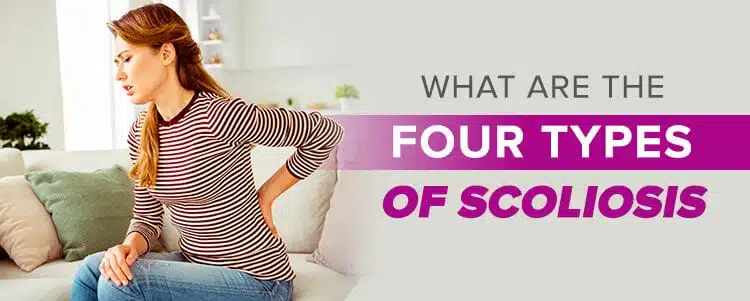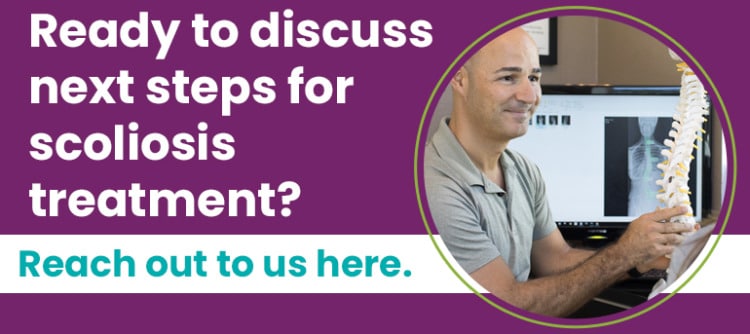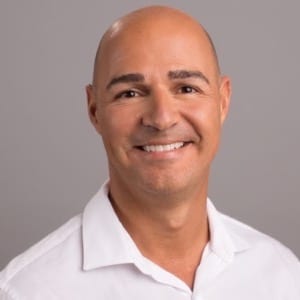While people are most familiar with three main types of scoliosis, there are actually four types that can develop: congenital, neuromuscular, adolescent idiopathic scoliosis, and adult de novo scoliosis. While these different types have different causes and age groups they affect, they progress relatively the same.
Understanding Scoliosis
Definition of Scoliosis
Scoliosis is a complex structural spinal condition characterized by an abnormal curvature of the spine. Unlike a healthy spine, which appears straight when viewed from the back, a spine with scoliosis curves to the side, forming an “S” or “C” shape. This condition is three-dimensional, affecting the coronal (frontal), sagittal (side), and axial (horizontal) planes of the body. Scoliosis can arise from various factors, including genetic predispositions, age-related wear and tear, and underlying medical conditions. It can affect individuals of all ages, from infants to adults, and significantly impact their quality of life by causing pain, discomfort, and mobility issues.
Different Types of Scoliosis
Although there are still many unanswered questions regarding how and why the bulk of scoliosis cases develop, there are known causes for three of the four main types of the condition: congenital, neuromuscular, and adult denovo scoliosis. The fourth category, idiopathic, is mainly associated with children but can develop in adults as well.
While congenital, neuromuscular and some types of adult-onset denovo scoliosis have known causes, these only make up 20 percent of diagnosed scoliosis cases, and the remaining 80 percent are defined as idiopathic, meaning they have no known single cause.
Congenital, neuromuscular, and idiopathic scoliosis are mainly associated with children.
Congenital Scoliosis
Congenital scoliosis is a spinal deformity that people are born with. In these cases, there is a bone malformation that can cause a scoliosis to develop. Although we understand how incorrect bone formations can cause a spinal deformity, experts are still unsure why people are born with the bone malformation to begin with.
If you think of a healthy spinal cord as rectangles stacked on top of each other like bricks, with congenital scoliosis, one of those bricks is shaped like a triangle and that causes the spine to tilt or curve.
Neuromuscular Scoliosis
Neuromuscular scoliosis develops in children with medical conditions that impair the body’s ability to control the muscles supporting the spine. Some of the most common medical conditions that cause neuromuscular scoliosis to develop include Marfan syndrome, muscular dystrophy, cerebral palsy, and spina bifida.
In most cases of neuromuscular scoliosis, the scoliosis that develops is secondary to the other medical problems the patient has.
Marfan syndrome
Marfan syndrome is understood as a genetic disorder of the body’s connective tissue. It commonly affects tall and thin people with long limbs. Approximately six out of ten people with Marfan also have scoliosis. While the scoliosis that can develop with Marfan syndrome is not typically severe, a growth spurt in a child with Marfan can cause the scoliosis to progress.
Muscular Dystrophy
Muscular dystrophy (MD) is a rare progressive disease that affects voluntary muscles that control movement of the legs, arms, and trunk. Scoliosis is a common problem for people with muscular dystrophy.
Duchenne MD accounts for 75-to-90 percent of scoliosis cases that develop as a result of the body’s muscle impairment.
Cerebral Palsy
Cerebral Palsy is a condition characterized by impaired muscle coordination. In many cases, cerebral palsy develops in children as a result of brain damage that occurred before or during delivery.
Children with cerebral palsy have significantly elevated chances of developing scoliosis. They are most likely to develop the condition during their early years and into adolescence. The severity of the scoliosis is closely linked to the severity of cerebral palsy and can progress beyond skeletal maturity.
Spina Bifida
Spina bifida is a congenital spinal defect where a gap in the backbone exposes part of the spinal cord and its meninges. It can cause paralysis of the lower limbs and can also affect mental function.
Approximately 50 percent of people with spina bifida will develop scoliosis. Children with spina bifida are at an elevated risk for rapid progression and large spinal curvatures. These patients are monitored closely to watch for progression during growth spurts.
Idiopathic Adolescent Scoliosis
When most people think of scoliosis, a 16-year-old girl comes to mind. While idiopathic scoliosis can develop in infants and juveniles, as well as adolescents, the most common age of diagnosis is between 10 and 18. This stage covers puberty and carries with it the highest risk of progression as growth spurts are a huge factor for this age group.
AIS is the most common form of the condition, affecting 4-to-5 percent of adolescents. Idiopathic adolescent scoliosis is more common in females, and while the reasons aren’t fully understood, a commonly-accepted theory is that it’s to do with postural maturity. As females tend to have larger growth spurts in shorter amounts of time, this tendency increases the likelihood of females developing idiopathic adolescent scoliosis. Early scoliosis diagnosis is crucial for effective treatment, as it allows for timely intervention and better management of the condition.
Multifactorial Causation
Understanding multifactorial causation is an important aspect of understanding the nature of idiopathic conditions. When a condition is defined as idiopathic, the condition’s development can’t be tied down to one single specific cause. That’s not to say that an idiopathic condition can’t have multiple causes; this is referred to as multifactorial causation.
When it comes to idiopathic scoliosis, it’s generally accepted that it likely develops due to a combination of variables and that those variables can differ from patient to patient. From possible genetic predispositions, environmental factors to hormone and muscle imbalances, we just don’t know which variables result in the development of abnormal spinal curvatures.
Adult De Novo Scoliosis
Adult de novo scoliosis makes up the fourth type of the condition, and is most common among adult scoliosis patients.
While many cases of adult scoliosis are extensions of adolescents who weren’t diagnosed and progressed into adulthood with the condition, de novo scoliosis cases are different.
Adults with no history of scoliosis during adolescence who develop the condition fall into the ‘de novo scoliosis’ category. In the majority of these cases, spinal deformities develop because of degenerative changes to the spine that accompany aging. Lumbar scoliosis, a specific curvature in the lower back, often develops due to these degenerative changes, leading to asymmetry in the hips and legs.
Under this umbrella, there are four types of scoliosis that adults can develop: degenerative, traumatic, pathological, and idiopathic.
Degenerative Scoliosis
Degenerative scoliosis occurs in older individuals whose spinal discs are deteriorating due to the natural effects of aging, and this can lead to the development of an abnormal spinal curvature. This condition often affects the lumbar spine due to age-related wear and tear.
Traumatic Scoliosis
While experts are unsure of how severe a trauma has to be to cause the development of the condition, accidents can cause spinal deformities to develop.
Pathological Scoliosis
Pathological scoliosis develops when tumors are present and pressing on the spine. The pressure the tumors exert on the spine can cause a curvature to develop.
Idiopathic Adult Scoliosis
While they can develop, instances of adult idiopathic scoliosis are rare. In most cases, as mentioned earlier, they are extensions of AIS cases that went undiagnosed, but of course, these cases are difficult to confirm and track.
Scoliosis by Age Group
Early Onset Scoliosis
Early onset scoliosis refers to scoliosis that occurs in children under the age of 10. This type of scoliosis is often linked to underlying medical conditions such as cerebral palsy or muscular dystrophy. Diagnosing early onset scoliosis can be challenging because the symptoms may be subtle and not immediately apparent. However, early detection is crucial. Identifying and treating the condition early can prevent the spinal curvature from worsening and improve overall treatment outcomes. Children with early onset scoliosis require close monitoring and, in some cases, early intervention to manage the condition effectively.
Adolescent Scoliosis
Adolescent scoliosis, also known as adolescent idiopathic scoliosis (AIS), is the most common type of scoliosis, accounting for approximately 80% of all cases. It typically manifests during puberty, between the ages of 10 and 18, and is more prevalent in girls than boys. The exact cause of adolescent scoliosis is not fully understood, but it is believed to involve a combination of genetic factors, hormonal changes, and rapid growth spurts. The severity of adolescent scoliosis can vary widely, from mild cases that require minimal intervention to severe cases that may necessitate bracing or surgery to prevent further progression and alleviate symptoms. Early diagnosis and appropriate treatment are essential to manage the condition effectively and maintain a good quality of life.
Interesting Facts and Stats about Scoliosis
Scoliosis is a complex condition that is still a subject of great debate in the medical community. While statistics aren’t the most important factor to consider, they do help give people a better understanding of the condition’s commonality. Following are some interesting facts and stats about scoliosis:
- Congenital, neuromuscular, traumatic, and pathological scoliosis are the only forms of the condition with known causes; these only make up 20 percent of scoliosis cases in the United States (Scoliosis Hope).
- Approximately 80 percent of scoliosis cases are classed as idiopathic with no known single cause (Scoliosis Hope).
- There are more than 4 million people living with scoliosis in the United States
- Scoliosis is the most common spinal deformity amongst school-aged children (Chiro & Osteo, 2005).
- Scoliosis is the cause of 20 percent of all spinal-deformity cases in the United States.
- Specialized chiropractic treatment for scoliosis helps 95 percent of scoliosis patients achieve a reduction and avoid invasive surgery (CLEAR Scoliosis Institute).
- Congenital scoliosis is only present in 1 out of 10,000 newborns.
- Cerebral palsy is a neuromuscular condition with a 25 percent incidence rate for developing scoliosis.
- Duchenne muscular dystrophy is a neuromuscular condition with a 90 percent incidence rate for developing scoliosis.
- Approximately 60 percent of the population of people over the age of 60 has mild degenerative scoliosis.
Conclusion
Scoliosis is the leading cause of spinal deformities among children and can affect infants, juveniles, and adolescents. While the condition is mainly associated with children, it can affect adults as well.
Most people are familiar with the three types of the condition associated with children – congenital, neuromuscular, and adolescent idiopathic scoliosis – while the fourth type that affects adults is often overlooked.
This tendency to focus on the three condition types is understandable; the majority of adult de novo scoliosis cases have known causes, but cases of the condition with known causes only make up 20 percent of known diagnosed cases. These numbers are significant and indicate the commonality of idiopathic cases, versus cases of adult de novo scoliosis.
Regardless of what has caused a patient’s scoliosis to develop, progression is relatively similar across the board, with growth being the big factor. Regardless of whether or not the cause of a patient’s condition is known, effective treatment is still very possible.
Here at the Scoliosis Reduction Center®, we have experience dealing with every type and severity level of the condition and have seen marked improvements in 98 percent of the patients who commit to our chiropractic-centered treatment plan.





